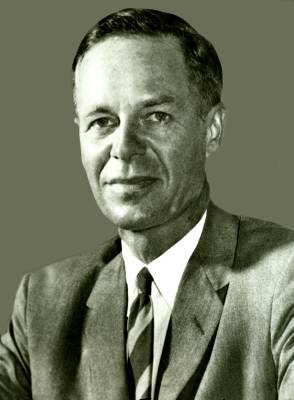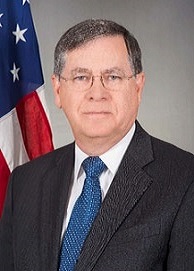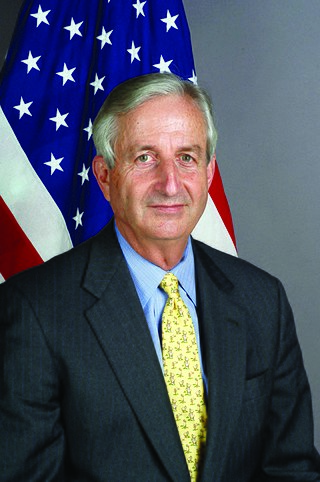
Charles Woodruff Yost was a career U.S. Ambassador who was assigned as his country's representative to the United Nations from 1969 to 1971.
Diplomatic rank is a system of professional and social rank used in the world of diplomacy and international relations. A diplomat's rank determines many ceremonial details, such as the order of precedence at official processions, table seatings at state dinners, the person to whom diplomatic credentials should be presented, and the title by which the diplomat should be addressed.

David Michael Satterfield is an American diplomat and ambassador, who has served extensively in the Middle East, including the Persian Gulf area, Lebanon, and Iraq. He later served as a senior advisor on Iraq for Secretary of State Condoleezza Rice and was director general of the Multinational Force and Observers, the peacekeeping force for the Sinai Peninsula from June 2009 until August 2017. He was chargé d'affaires to Egypt from August 2013 to January 2014 and was subsequently Special Advisor to the Secretary of State for Libya. From September 2017 to June 2019 he served as the acting assistant secretary of state for Near Eastern affairs, and was confirmed as U.S. ambassador to Turkey on June 27, 2019.
Assistant Secretary of State (A/S) is a title used for many executive positions in the United States Department of State, ranking below the under secretaries. A set of six assistant secretaries reporting to the under secretary for political affairs manage diplomatic missions within their designated geographic regions, plus one assistant secretary dealing with international organizations and one equivalent as the coordinator/ambassador at large for counterterrorism. Assistant secretaries usually manage individual bureaus of the Department of State. When the manager of a bureau or another agency holds a title other than assistant secretary, such as "director", it can be said to be of "assistant secretary equivalent rank". Assistant secretaries typically have a set of deputies, referred to as deputy assistant secretaries (DAS).

The School of International and Public Affairs (SIPA) is the international affairs and public policy school of Columbia University, a private Ivy League university located in Morningside Heights, Manhattan, New York City. SIPA offers Master of International Affairs (MIA) and Master of Public Administration (MPA) degrees in a range of fields, as well as the Executive MPA and PhD program in Sustainable Development.

Michele Jeanne Sison is an American diplomat and career member of the Senior Foreign Service serving as the assistant secretary of state for international organization affairs. She has previously served in various other diplomatic posts around the world on behalf of the United States, including ambassador to Haiti. Sison holds the personal rank of career ambassador.
Executive Schedule is the system of salaries given to the highest-ranked appointed officials in the executive branch of the U.S. government. The president of the United States appoints individuals to these positions, most with the advice and consent of the United States Senate. They include members of the president's Cabinet, several top-ranking officials of each executive department, the directors of some of the more prominent departmental and independent agencies, and several members of the Executive Office of the President.

The Distinguished Honor Award is an award of the United States Department of State. Similar versions of the same award exist for the former U.S. Information Agency, Arms Control and Disarmament Agency, and USAID. It is presented to groups or individuals in recognition of exceptionally outstanding service or achievements of marked national or international significance.

The Superior Honor Award is an award of the United States Department of State. Similar versions of the same award exist for the former U.S. Information Agency, Arms Control and Disarmament Agency, and USAID. It is presented to groups or individuals in recognition of a special act or service or sustained extraordinary performance covering a period of one year or longer.

Eric J. Boswell is an American diplomat who served as the Assistant Secretary of State for Diplomatic Security from 2008 to 2012. He previously served in the same post from 1996 to 1998.
African-Americans in foreign policy in the United States catalogs distinguished African Americans who have and continue to contribute to international development, diplomacy, and defense through their work with the U.S. Department of State, the U.S. Agency for International Development, the U.S. Information Agency, and the U.S. Congress, and other notable agencies and non-governmental organizations. The creators acknowledge the presence of the interagency contributions to the foreign affairs realm, and welcome additional content to showcase the achievements of African-Americans in other relevant USG agencies.
The order of precedence in the Philippines is the protocol used in ranking government officials and other personages in the Philippines. Purely ceremonial in nature, it has no legal standing, and does not reflect the presidential line of succession nor the equal status of the three branches of government established in the 1987 Constitution.

Glyn Townsend Davies is a senior advisor at ASG, a strategy and commercial diplomacy firm. A career member of the U.S. Senior Foreign Service, he served as U.S. Ambassador to the United Nations International Organizations in Vienna from 2009 to 2011, as Special Representative for North Korea Policy from 2011 to 2014, and as Ambassador to Thailand from 2015 to 2018.
The Honourable or The Honorable is an honorific style that is used as a prefix before the names or titles of certain people, usually with official governmental or diplomatic positions.

Bathsheba "Sheba" Nell Crocker is an American diplomat who is currently serving as the Representative of the United States to the European Office of the United Nations. She previously served as Assistant Secretary of State for International Organization Affairs from 2014 to 2017.

The following is a timeline of the presidency of Jimmy Carter from his inauguration as the 39th president of the United States on January 20, 1977, to December 31, 1977.

Robert A. Wood is an American diplomat who is the Alternate Representative of the United States of America for Special Political Affairs in the United Nations, with the rank of Ambassador.










